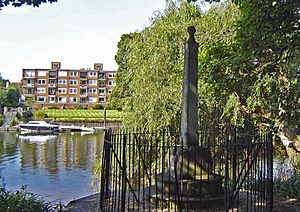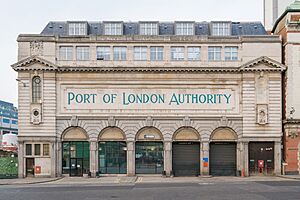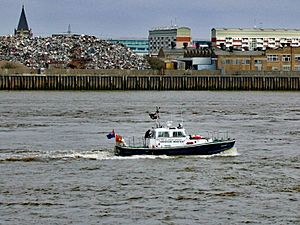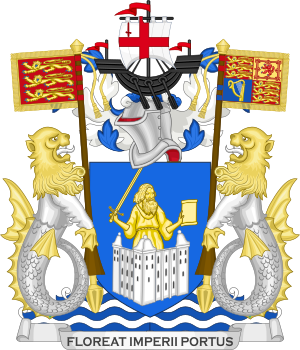Port of London Authority facts for kids

Logo
|
|
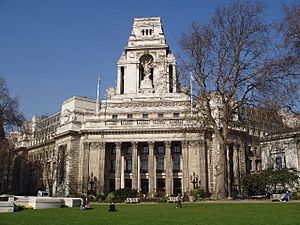
Former headquarters, Tower Hill
|
|
| Predecessor |
|
|---|---|
| Formation | 31 March 1909 |
| Type | Public trust |
| Purpose | Operation of the Port of London |
| Headquarters | London River House |
| Location | |
|
Region
|
Kent |
|
Chair
|
Jonson Cox CBE |
|
Chief Executive
|
Robin Mortimer |
|
Staff (2022)
|
460 |
The Port of London Authority (PLA) is a special organization that manages the Port of London. It was created on March 31, 1909. The PLA's main job is to keep the River Thames safe for ships. It also protects the river's environment.
The PLA looks after the tidal part of the River Thames. This means the part of the river where the tide goes in and out. It used to run all the big docks on the river. Today, most of these docks are closed to commercial ships. Only the Port of Tilbury is still used for large cargo.
Contents
How the PLA Works
Funding the PLA
The PLA does not get money from the government. It pays for itself by charging fees. These fees come from ships and cargo using the river. They also charge for things like guiding ships and checking the river's depth.
Where the PLA Operates
The PLA is in charge of about 95 miles (150 km) of the River Thames. This starts just after Teddington Lock. It goes all the way to where the river meets the North Sea. This area is between Margate in the south and Frinton-on-Sea in the north. The PLA does not manage the River Medway or The Swale.
For a long time, the PLA owned many docks and wharves. These are places where ships load and unload goods. Now, these places are either closed or owned by private companies. Today, the PLA mainly makes sure the river is safe for boats. It also helps the port and its activities run smoothly. Another group, the Environment Agency, manages the river upstream from Teddington Lock.
What the PLA Does
The PLA has several important duties. These include:
- Controlling river traffic to prevent accidents.
- Ensuring safety for ships, including guiding them.
- Placing buoys and beacons to mark safe paths.
- Checking the river's depth and keeping channels clear.
- Protecting the river's environment.
- Encouraging both business and fun activities on the river.
The PLA also runs Richmond Lock. However, the Thames Barrier, which protects London from floods, is managed by the Environment Agency.
River Managers
The PLA has a team of experts who manage the river. They are called harbour masters. The main person in charge is the Chief Harbour Master. This team makes sure that all the rules for safe navigation are followed. They cover the entire river area managed by the PLA.
PLA Locations and Operations
Main Offices
The PLA's main office is in Gravesend. It is located at London River House and Royal Terrace Pier. They also have an office in the City of London. This is where the Chair and Chief Executive work.
River Control Centres
The PLA uses two special centres to control ship traffic. These are like air traffic control, but for boats!
- The Thames Barrier Navigation Centre in Woolwich handles traffic upstream.
- Port Control Gravesend is the main centre. It manages traffic downstream.
Both centres use a system called Vessel Traffic Services (VTS). This system uses 16 radar stations along the river. This helps them see and guide all the boats.
Other Facilities
The PLA owns Denton Wharf and Jetty in Gravesend. This is where they keep and fix their fleet of over 40 vessels. They also have Barrier Gardens Pier and Unity House near the Thames Barrier. These places are useful for their boats that clear debris from the river. There are also two pilot stations further out at sea. These stations help pilots get on and off large ships entering or leaving the Port.
As of 2022, about 460 people worked for the PLA.
Piers and Jetties Owned by PLA
The PLA owns six piers and jetties on the River Thames. These are available for other river users, not just the PLA's own boats.
- Barrier Gardens Pier and Unity House, Woolwich
- Royal Terrace Pier and landing stage, Gravesend
- Denton Wharf and Jetty, Gravesend
- Masthouse Terrace Pier, Isle of Dogs
- Peruvian Wharf, Newham
- Royal Primrose Wharf, Newham
PLA Vessels
The PLA has many different types of boats. They have four boats for surveying the river. They also have eight smaller boats for patrols. In total, they have over 40 vessels. Five new patrol boats were built in 2009.
Harbour Service Boats
- Chelsea and Richmond: These are catamarans. They are designed to work in shallow water in the upper parts of the port.
- Lambeth, Kew, Southwark, and Barnes: These catamarans work in the lower tidal waters. They are also used to carry river pilots.
- Easthaven and Crane: These are small, fast boats called RIBs. They are used in shallow areas.
Marine Service Boats
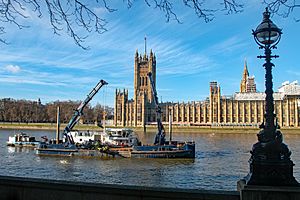
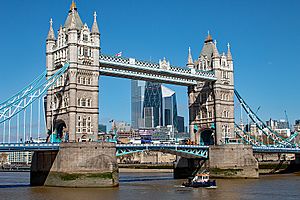
- London Titan: This boat helps maintain moorings for other vessels.
- Driftwood II and Driftwood III: These boats are mainly used to clear wood and other rubbish from the river. They can also help with salvage operations.
- PLA Diver: This boat supports divers working in the river.
- Impulse: This is a tugboat that pushes barges. It also helps with salvage and clearing the river.
- Recover and Respond: These boats are used to clean up oil spills.
- Gunfleet: An open-deck RIB.
- Benfleet: A RIB with a wheelhouse, used for moving crew members.
River Survey Boats
- Maplin, Thame, Yantlet, and Galloper: These catamarans have special equipment. They are used to map the riverbed and check its depth. There is also a small RIB for very shallow areas.
Pilot Boats
- Patrol: This boat is based at Gravesend.
- Guide: This boat is also based at Gravesend.
- Leader: This is a modern boat that uses both diesel and electric power. It was delivered in 2019 and is based at Gravesend.
- Six other pilot boats are based at Ramsgate and Sheerness. They are operated by a company partly owned by the PLA.
PLA History and Traditions
Railways of the Past
The PLA used to have its own railway system. This was inherited from the companies that ran the docks before the PLA. They had engine sheds, signal boxes, and level crossings. Their trains moved goods around the docks and factories. The PLA used steam locomotives at first. These were replaced by diesel trains in the late 1950s. However, the railway system closed in 1970 as fewer goods were moved by train.
Special Traditions
The Lord Mayor of London has a special title: Admiral of the Port of London. This is an honorary role.
The PLA uses a special flag on its vessels. It is a blue flag with a gold sea-lion on it. They also have flags for their chairman and vice chairman.
The PLA's coat of arms was given to them in 1909. It shows a castle and a figure holding a sword and a scroll. This represents the Tower of London and St Paul, London's patron saint. The crest shows an old ship with the City of London's arms on its sail. The supporters are two sea-lions. One holds the banner of King Edward II, and the other holds the banner of King Edward VII.
The PLA's motto is in Latin: "Floreat Imperii Portvs". This means "May the Port of the Empire Flourish".
See Also
- London River Services
- List of locations in the Port of London
- List of navigation authorities in the United Kingdom


